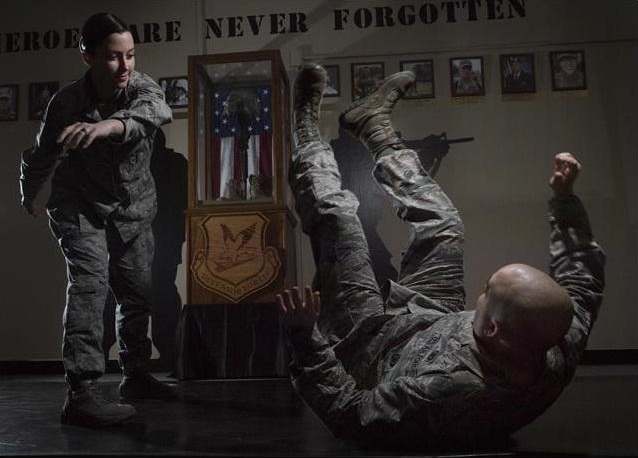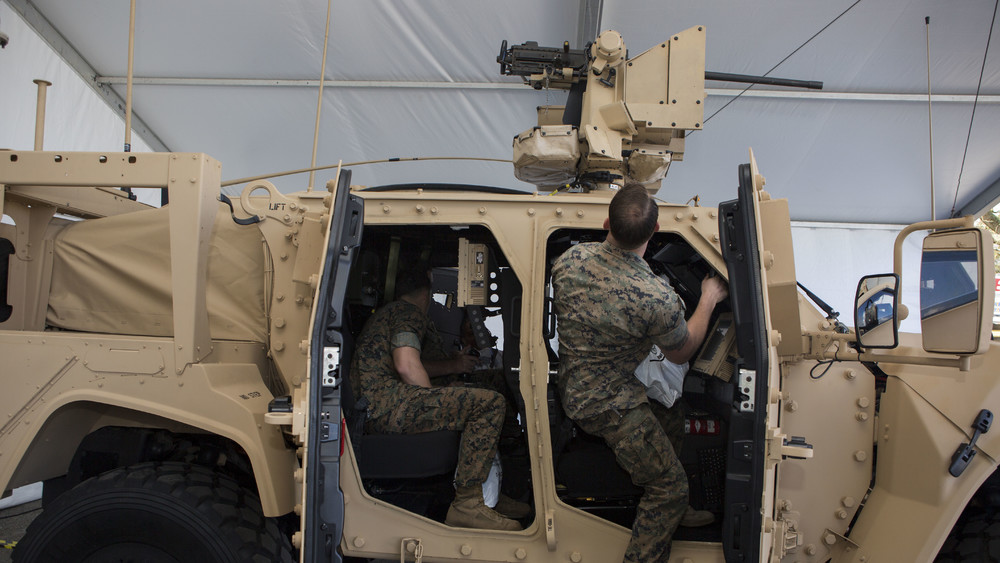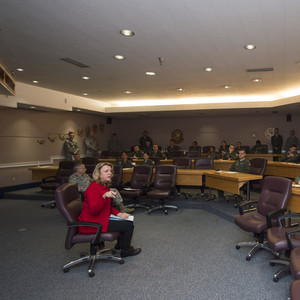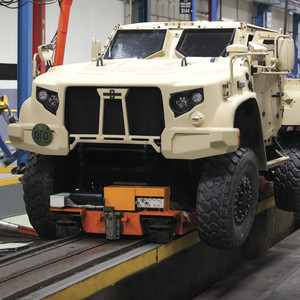Breaking the Stereotype: Tutus to Takedowns
by: Senior Airman Elizabeth Baker,
Stars & Stripes Japan, Yokota Air Base, published: February 04, 2017

Staff Sgt. Kiirsten Gunterman, 374th Security Forces Squadron training instructor, performs a takedown on Senior Airman Ryan Vanicek, 374 SFS unit training manager at Yokota Air Base, Japan, Jan. 20, 2017. Gunterman spent 17 years practicing ballet before joining the Air Force. Her duties include instructing Combatives classes, where she teaches defenders to overcome larger, stronger oponents. (U.S. Air Force photo by Senior Airman Elizabeth Baker)
YOKOTA AIR BASE, Japan -- Air Force Security forces personnel exist to secure, defend and fight. Their responsibilities include protecting some of the world’s most potentially lethal weapons, securing air bases around the globe and handling combat arms. The kind of person who aspires to become an Air Force defender might be passionate about criminal justice, or attracted to danger or practice… ballet?
Standing a little over 5 feet, with the typical petite, slender and poised stature of a dancer, Staff Sgt. Kiirsten Gunterman,374th Security Forces Squadron training instructor, practiced ballet for 17 years before she joined the Air Force. With her passion for dance and her role as a defender, personnel like Gunterman demonstrate that in the Air Force there are always those who will break stereotypes. Whether male or female, ballerina or mechanic, drive and attitude are what make an Airman.
“People expected me to fail,” Gunterman said.
Before she joined, Gunterman visited recruiters from every branch. After watching an Air Force recruiting video about Security Forces, she decided the job was perfect and signed to be a cop.
“When I joined the military it surprised a lot of people,” Gunterman said as she looked toward the ceiling, reaching back to memories of her senior high school year in Chico, California. “I was the dancer, I did cheerleading and other things. People were saying ‘Does she know what she just signed up for?’ Now here I am, a military police officer.”
According to Gunterman, joining the military may have been a leap of faith but she embraced where it lead her.
“I definitely made the right decision joining the Air Force,” Gunterman said without hesitation. “Having my airmen is my favorite part. I didn’t think it would be but it’s really rewarding to see your airmen succeed. And to have them come up to you and say ‘Thank you for being the way you are,’ it hits you right in the heart.”
“Exuberance,” said Senior Airman Ryan Vanicek said with a smile when asked to describe her.
Vanicek, who is a 374 SFS unit scheduler, said he looks to Gunterman not only as his supervisor but as a role model. While firm, she does not come off as gruff in any way. Rather, Gunterman is endlessly enthusiastic.
“If I had to describe Staff Sgt. Kiirstyn Gunterman in a couple of words, another would be fierce,” Vanicek said lightheartedly but with conviction. “Her presence is strong. You always know when she is in a room.”
Gunterman says she loves her job. She spoke with energy about the study opportunities, the people she has met and the places she has been. Yet, in younger years, Gunterman never would have expected to end up where she is today.
“I had every intention of moving to the east coast and going to the college of my dreams and dancing with the New York Ballet Company,” Gunterman said. “That was gonna be my life.”
When Gunterman talks about dance and the dancers she admires, she becomes energized by thoughts of beauty and creativity.
“I think dance is really beautiful,” Gunterman said, her brown eyes turning to the side to follow her imagination. “When you see a dancer put their heart and soul into a piece, you can feel it. If someone loves what they’re doing and the story they’re telling, it becomes art that’s living, breathing and fluid. I think it’s one of the most beautiful art forms there is.”
Before graduating high school, Gunterman experienced events that changed the way she saw the world.
“When I was 16 my parents split up and my outlook on the world changed a little bit,” Gunterman said and paused briefly before continuing. “I made some changes but I love my life now.”
While hunting for a new direction, Gunterman turned to the Air Force: a branch she’d admired since she was young.
“I’d always thought of the Air Force as the best of the best,” Gunterman said. “They were the innovators, doing the big things in the world, and I wanted to do big things in the world. I said ‘I wanna go make change.’”
The young woman set out to become a defender, yet, the journey wasn’t easy from the start. Though years of dance had built her strength, Basic Military Training challenged her with 40 minute runs that required the kind of cardio stamina she simply didn’t have.
However, Gunterman pressed on, became an Airman, trained and learned. She pressed on through days where she began to doubt her decision.
“It was raining, 30 degrees, standing outside guarding a nuclear weapon and I was like ‘This sucks!’” Gunterman said, her eyes widening. “There were times in Colorado, in negative 17 degrees, standing at the gate and checking identification cards. You start to fantasize about what could have been.”
According to Gunterman, never was her self-drive more challenged than when she volunteered to become a Combatives instructor.
All SFS personnel have to stay current in techniques, largely based on jiu-jitsu ground fighting, which allow them to subdue an individual without taking or causing injuries. They practice these techniques in a class called Combatives.
“When I started learning to be an instructor, I didn’t think I could do it,” Gunterman said. “It whooped my butt. I’ve never been that sore in my entire life.”
Gunterman experienced mental and physical exhaustion in a class where she was the only female. Larger classmates continually defeated her and yet, by the end of the class, she learned to overcome them.
“Doing ballet taught me discipline,” Gunterman said. “They give you a task and you have to keep doing it and doing it to perfect it, no matter how much your feet bleed or your legs hurt. I knew people were relying on me to perfect that task because I needed to know it for a piece or a competition.”
Though Gunterman may have doubted herself at times and others may have seen her as an unlikely candidate for the military or SFS, none of that ever made this ballerina-cop quit.
“I’ve had people along the way tell me ‘You’re too girly’ or ‘This career field doesn’t seem too right for you,’ Gunterman said. “But I’ve made it my own experience. My outlook is, ‘you’re not getting out of life alive so you may as well have a good time with it. It sucks being in 17 degree weather but tomorrow I may not be. Or here I am checking IDs but if I wasn’t here these people couldn’t come on base and go to their homes.’”
Gunterman’s determination has made an impression on others too.
“She has never been one to be told something can't be done,” Vanicek said. “I have watched her many times find a way even if she had to make a way. On the other side of the coin, she is compassionate and cares for her subordinates, to include myself. She is empowering, I have grown more as an Airman during my time with her than probably any other time in my career.”
Perhaps it should have been apparent from the moment Gunterman decided to be a cop that she would become one and a good one. Being a ballerina didn’t mean she couldn’t handle SFS. In fact, it built her physical, mental and emotional discipline.
“I think that women get a bad rap sometimes,” Gunterman said. “I think we get underestimated a little in every branch.”
When Gunterman was asked what she would say to other young women who may be intimidated about joining the Air Force, she considered her response carefully.
“Sometimes you have to take a leap of faith,” Gunterman said. “People in the Air Force won’t let you fall flat on your face. Everyone wants you to succeed. This is a family. Why not to the next adventure? I started my life in Chico, California, and now I’m here. I can’t wait for the next adventure that comes.”
So far, Gunterman’s drive and her attitude have carried her to where she is today and made her what she is: a dancer and a hell of an Airman.

DHS/TSA Coordination Center Officer
Save Job | More Like This
Salary:
$48,348.00 - $72,600.00 / Per Year
Series & Grade:
SV-0086-F/F
Location(s):
San Francisco, California
Open Period:
1/19/2017 to 1/24/2017
Announcement Number:
SFO-17-232571
Department:
Department Of Homeland Security
Agency:
Transportation Security Administration
Position Info:
Full Time - Permanent
Who May Apply:
Open to all U.S. Citizens. Salary range listed includes Locality Pay of 38.17%. ...
The SFO coordination center is a 24/7 communication center. Requires ability to know and follow established emergency action plans. High performing, responsible vets are highly desired.
Anthony M. Mira
Dept of Homeland Security / TSA
Deputy Federal Security Director
San Francisco International Airport, CA
Mobile: (650) 730-0467
Desk: (650) 266-1903
e-mail: This email address is being protected from spambots. You need JavaScript enabled to view it.

Military.com | Jan 19, 2017 | by Matthew Cox and Hope Hodge Seck
LAS VEGAS -- The U.S. Army on Thursday awarded Sig Sauer a contract worth $580 million to make the next service pistol based on the company's P320 handgun.
Sig Sauer beat out Glock Inc., FN America and Beretta USA, the maker of the current M9 9mm service pistol, in the competition for the Modular Handgun System, or MHS, program.
"We are both humbled and proud that the P320 was selected by the U.S. Army as its weapon of choice," Ron Cohen, chief executive officer of Sig Sauer, said in a statement to Military.com here at SHOT Show, the world's largest gun show, taking place this week in the city.
"Securing this contract is a testimony to Sig Sauer employees, their commitment to innovation, quality and manufacturing the most reliable firearms in the world," Cohen added.
The 10-year agreement calls for Sig to supply the Army with full-size and compact versions of the gun. The pistols can be outfitted with silencers and accommodate standard and extended capacity magazines. The firearms will be manufactured at the company's facilities in New Hampshire.
The Army launched its long-awaited XM17 MHS competition in late August 2015 to replace its Cold War-era M9 9mm pistol.
"By maximizing full and open competition across our industry partners, we have optimized private sector advancements in handguns, ammunition and magazines, and the end result will ensure a decidedly superior weapon system for our warfighters," Army Acquisition Executive Steffanie Easter said said in a press release.
One of the major goals of the effort was to adopt a pistol chambered for a more potent round than the current 9mm. The U.S. military replaced the .45 caliber 1911 pistol with the M9 in 1985 and began using the 9mm NATO round at that time.
In their statements, Army and Sig officials didn't specify what caliber the new Sig Sauer pistol will be.
Sig touts the P320 model product as "modular" and "adaptable," with interchangeable grips, multiple sizes and calibers that can be converted between 9mm, .357SIG and .40SGW. "From calibers, to pistol size, to the grip fit best suited for the shooter, the P320 is the most adaptable pistol available today," the company says in promotional materials.
Two sources confirmed to Military.com that Sig submitted to the Army .40-caliber and 9mm pistols for consideration. One source said the Army ultimately selected the 9mm version.
Shortly after the contract announcement, Sig officials celebrated here at the show. Staff at the Sig Sauer booth set out champagne flutes for a celebratory toast.
The Army in December down-selected to two finalists for the competition: Sig and Glock, which had submitted its Glock 17 and Glock 19 models for consideration. Given the size of the contract, Glock is widely expected to protest the decision.
Brandie Collins, communications manager for Glock, said she had not been briefed on the contract award but wished the winners well.
Army officials informed Beretta USA and FN America at the show that they had been dropped from the competition in the recent down-select decision, according to a service source who is not authorized to speak to the press. But confusion reigned as reporters informed company officials of the Army's announcement.
The decision formally ends the Beretta's 30-year hold on the Army's sidearm market.
Gabrielle de Plano, vice president of Beretta Defense Technologies marketing and operations, said staff were still reading through the contract announcement to fully understand it.
"It's going to have to be a no comment from us for now," he said.
Beretta has fought hard to remain to remain the Army's pistol maker. In December 2014, Beretta USA submitted its modernized M9A3 as a possible alternative to the Army's Modular Handgun System program.
But the Army rejected the improved M9A3, which featured new sights, a rail for mounting lights and accessories, better ergonomics and improved reliability. The company, however, wasn't finished yet. It developed a new striker-fired pistol, the APX, and entered it into the competition.
Kristina DeMilt, public relations for FN, said officials at the show hadn't been informed of the award and were not immediately prepared to comment.
The Army began working with the small arms industry on Modular Handgun System in early 2013, but the joint effort has been in the works for more than five years. It could result in the Defense Department buying nearly 500,000 new pistols.
Current plans call for the Army to purchase more than 280,000 handguns, according to Program Executive Office Soldier officials. The Army also plans to buy approximately 7,000 sub-compact versions of the handgun.
The other military services participating in the program may order an additional 212,000 systems above the Army quantity.
"As MHS moves forward into operational testing, the due diligence taken by all of the stakeholders will ensure a program that remains on-budget and on-schedule," Easter said.
Lawmakers may be eager to hear such an assessment.
During last week's confirmation hearing for retired Marine Gen. James Mattis to become defense secretary in the Trump administration, Republican Sens. Joni Ernst of Iowa and Thom Tillis of North Carolina took turns criticizing what they described as an overly bureaucratic effort, with technical requirements totaling several hundred pages.

By: Karen Jowers, Military Times, December 21, 2016
'Tis the season for seeking out scholarships, and the Fisher House Foundation has launched a free search tool to help troops, veterans and families get their share of these education-budget boosters.
The Scholarships for Service tool can help those with any affiliation – active- or reserve-component members, veterans, retired military personnel and military family members. There are more than 3,000 scholarships available to those with various affiliations in the military community, offered from organizations ranging from the military relief societies to associations for Seabees and 82nd Airborne Division troops, to name just a few.
The Fisher House Foundation has helped provide scholarships to military children and spouses for 17 years, and recognized through that work the need to help families search further, according to the group's CEO, Ken Fisher, in a statement announcing the new tool http://www.militaryscholar.org/
Because of this involvement, he said, “we routinely received calls asking if we knew of any other financial resources available to help service members, veterans, and their families with college funding. We did the best we could to pass on information about other scholarship programs, but we came to recognize that we were only scratching the surface and needed to do more.”
Unlike other scholarship search tools, Scholarships for Service is tailored specifically to search for scholarships that are available to those in the military community.
“We get questions about scholarships all the time,” said Brian Gawne, a retired Navy captain who is vice president of community relations for Fisher House Foundation.
Fisher House Foundation developed Scholarships for Service search tool with AdmitHub, which specializes in college application support, scholarship search assistance, and enrollment advising. Plans call for refining the tool as more users try it out, Gawne said; programmers already have added additional organizations, offering newer scholarships, to the database.
Students or students-to-be enter brief background information and education goals, and the tool will quickly identify potential military-affiliated scholarships. With each offering comes a summary of eligibility requirements, points of contact and links to the scholarship provider’s website. Students can have a PDF file of the results emailed to them.
Neither Fisher House Foundation nor AdmitHub collects any data from the site, Gawne said.
“You don’t have to register, we don’t collect information. We just wanted a pure service,” he said. “There won’t be any emails afterwards, because we don’t sell anything to marketing agencies. ... If nothing else, it gives a sense of how many scholarships there are out there.”
Karen Jowers covers military families, quality of life and consumer issues for Military Times. She can be reached at This email address is being protected from spambots. You need JavaScript enabled to view it.
The US Air Force Could Pick New Army-Marine Corps Ride to Guard Missile Field
By: Valerie Insinna, January 4, 2017, Defense News (Photo Credit: Lance Cpl. Austin M. Schlosser/US Marine Corps)

WASHINGTON — The Army and Marine Corps Joint Light Tactical Vehicle could be one option on the table as the Air Force seeks new vehicles for its security forces protecting missile-launch facilities. The service is in the earliest stages of the process, and no decisions have been made on the number of vehicles needed or whether to opt for a military-specific or commercial product, officials told Defense News. Procurement by the Air Force would be an unexpected boon for JLTV manufacturer Oshkosh Defense, which is eagerly looking to add to its customer base. At this point, requirements have been formalized by Air Force Global Strike Command and are currently being vetted by the Air Force’s Security Forces Center and the Vehicle Supply Chain Operations Squadron (VSCOS), Air Force spokesman Capt. Chris Mesnard said. Once they are set in stone, Air Force Materiel Command will take the lead in the acquisition process.

The Air Force needs a specialized vehicle for missile field security to replace the aging Humvees currently in operation, Maj. Gen. Michael Fortney, vice commander of Air Force Global Strike Command, said in a December interview. “We had been using up-armored Humvees for a long time,” he said. According to the Air Force, some of those models date as far back as 1998 and have not been modernized since their purchase, which Fortney said creates problems in upkeep. “Those [vehicles] are no longer going to be supportable in the DoD after a certain point in time. So what is the right vehicle for that mission set up there?” he said. Oshkosh’s Joint Light Tactical Vehicle is seen as one potential option. Air Force representatives visited Marine Corps Base Quantico in early December to see the ride in action, receiving briefings and demonstrations from Army and Marine Corps officials. Individuals from Air Force headquarters, Global Strike Command (AFGSC), AF Security Forces Center, VSCOS and Warner-Robins Air Logistics Complex were in attendance, Mesnard confirmed. Should the Air Force decide to buy into the JLTV program, it could benefit from the economies of scale inherent to such a large procurement. The Army and Marine Corps plan to buy a total 54,599 vehicles over the course of the program. The company delivered the first seven JLTVs to the Army and Marine Corps in late September. According to an Army statement, Oshkosh will provide about 100 vehicles over the next year for testing at Yuma Proving Ground, Arizona.

And once full-rate production starts in 2019, the services hope that lower-than-expected unit prices can drive bigger purchases every year, shaving about $6 billion in costs, Scott Davis, the Army’s program executive officer for combat support and combat service support, said in an October news release. Air Force officials stressed that no decision to procure the JLTV has been made. In an emailed response to questions, Mesnard said the service believes both military and commercial, off-the-shelf vehicles may be able to meet its requirements. The Air Force on Dec. 21 issued a request for information on tactical vehicles that will be used to help the service identify potential options ahead of a competition. The RFI includes divides vehicles into “Level 1” — ultra-light variants less than 10,000 pounds — and a larger “Level 2” vehicle that can weigh up to 20,000 pounds. The JLTV, which has a curb weight of 14,000, fits into the heavier category. Level 2 vehicles should also be able to meet speeds of at least 65 miles per hour, have a 3,000-pound payload capability, and have a fuel range of 350 miles while traveling at 35 miles per hour. The Level 1 vehicles have a smaller payload — only 1,500 pounds — but must be able to hit 75 mile per hour speeds. “The number of vehicles AFGSC will buy depends on things like procurement cost, mix of light and medium variants, available budget, etc.,” Mesnard stated. If the Air Force does opt for the JLTV, the service has also not determined whether it would need Oshkosh to modify the vehicles for service-specific requirements driven by the harsh, frigid climates of the northern-tier missile bases. Cost considerations and long lead time would likely preclude the service from purchasing a clean-sheet design, Mesnard said, adding that “the Air Force would only pursue a service-specific buy if a suitable joint vehicle was not available to meet mission requirements.”
A spokeswoman for Oshkosh declined to provide specifics about the company's level of involvement in the demonstrations to Air Force officials in Quantico, but signaled that the company would welcome adding a third US military service to its list of customers. "While we defer to the US government on their program requirements and procurement plans, we are confident that the JLTV platform provides superior performance, off-road mobility and protection for all services, including the Air Force,” Jennifer Christiansen, Oshkosh’s vice president of global strategy and marketing, said in a statement. “Oshkosh stands ready to produce JLTVs for all services to ensure our troops receive the next generation equipment the need to successfully complete their missions."
Page 39 of 50


